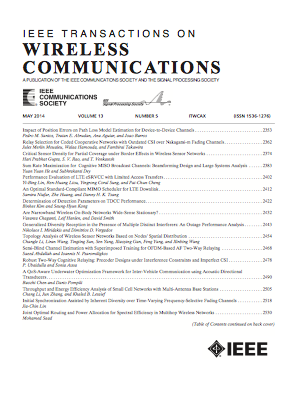A New Solution for MU-MISO Symbol-Level Precoding: Extrapolation and Deep Unfolding
IF 10.7
1区 计算机科学
Q1 ENGINEERING, ELECTRICAL & ELECTRONIC
引用次数: 0
Abstract
Constructive interference (CI) precoding, which converts the harmful multi-user interference into beneficial signals, is a promising and efficient interference management scheme in multi-antenna communication systems. However, CI-based symbol-level precoding (SLP) experiences high computational complexity as the number of symbol slots increases within a transmission block, rendering it unaffordable in practical communication systems. In this paper, we propose a symbol-level extrapolation (SLE) strategy to extrapolate the precoding matrix by leveraging the relationship between different symbol slots within in a transmission block, during which the channel state information (CSI) remains constant, where we design a closed-form iterative algorithm based on SLE for both PSK and QAM modulation. In order to further reduce the computational complexity, a sub-optimal closed-form solution based on SLE is further developed for PSK and QAM, respectively. Moreover, we design an unsupervised SLE-based neural network (SLE-Net) to unfold the proposed iterative algorithm, which helps enhance the interpretability of the neural network. By carefully designing the loss function of the SLE-Net, the time-complexity of the network can be reduced effectively. Extensive simulation results illustrate that the proposed algorithms can dramatically reduce the computational complexity and time complexity with only marginal performance loss, compared with the conventional SLP design methods.一种新的MU-MISO符号级预编码方法:外推和深度展开
构造干扰(CI)预编码将有害的多用户干扰转化为有益信号,是多天线通信系统中一种很有前途的有效干扰管理方案。然而,随着传输块中符号槽数的增加,基于ci的符号级预编码(SLP)具有很高的计算复杂度,使其在实际通信系统中难以承受。在本文中,我们提出了一种符号级外推(SLE)策略,通过利用传输块内不同符号槽之间的关系来外推预编码矩阵,在此期间信道状态信息(CSI)保持不变,我们设计了一个基于SLE的封闭形式迭代算法,用于PSK和QAM调制。为了进一步降低计算复杂度,进一步针对PSK和QAM分别开发了基于SLE的次优闭型解。此外,我们设计了一个无监督的基于sle的神经网络(SLE-Net)来展开所提出的迭代算法,这有助于增强神经网络的可解释性。通过对网络损失函数的精心设计,可以有效地降低网络的时间复杂度。大量的仿真结果表明,与传统的SLP设计方法相比,所提出的算法可以显著降低计算复杂度和时间复杂度,而性能损失很小。
本文章由计算机程序翻译,如有差异,请以英文原文为准。
求助全文
约1分钟内获得全文
求助全文
来源期刊
CiteScore
18.60
自引率
10.60%
发文量
708
审稿时长
5.6 months
期刊介绍:
The IEEE Transactions on Wireless Communications is a prestigious publication that showcases cutting-edge advancements in wireless communications. It welcomes both theoretical and practical contributions in various areas. The scope of the Transactions encompasses a wide range of topics, including modulation and coding, detection and estimation, propagation and channel characterization, and diversity techniques. The journal also emphasizes the physical and link layer communication aspects of network architectures and protocols.
The journal is open to papers on specific topics or non-traditional topics related to specific application areas. This includes simulation tools and methodologies, orthogonal frequency division multiplexing, MIMO systems, and wireless over optical technologies.
Overall, the IEEE Transactions on Wireless Communications serves as a platform for high-quality manuscripts that push the boundaries of wireless communications and contribute to advancements in the field.

 求助内容:
求助内容: 应助结果提醒方式:
应助结果提醒方式:


